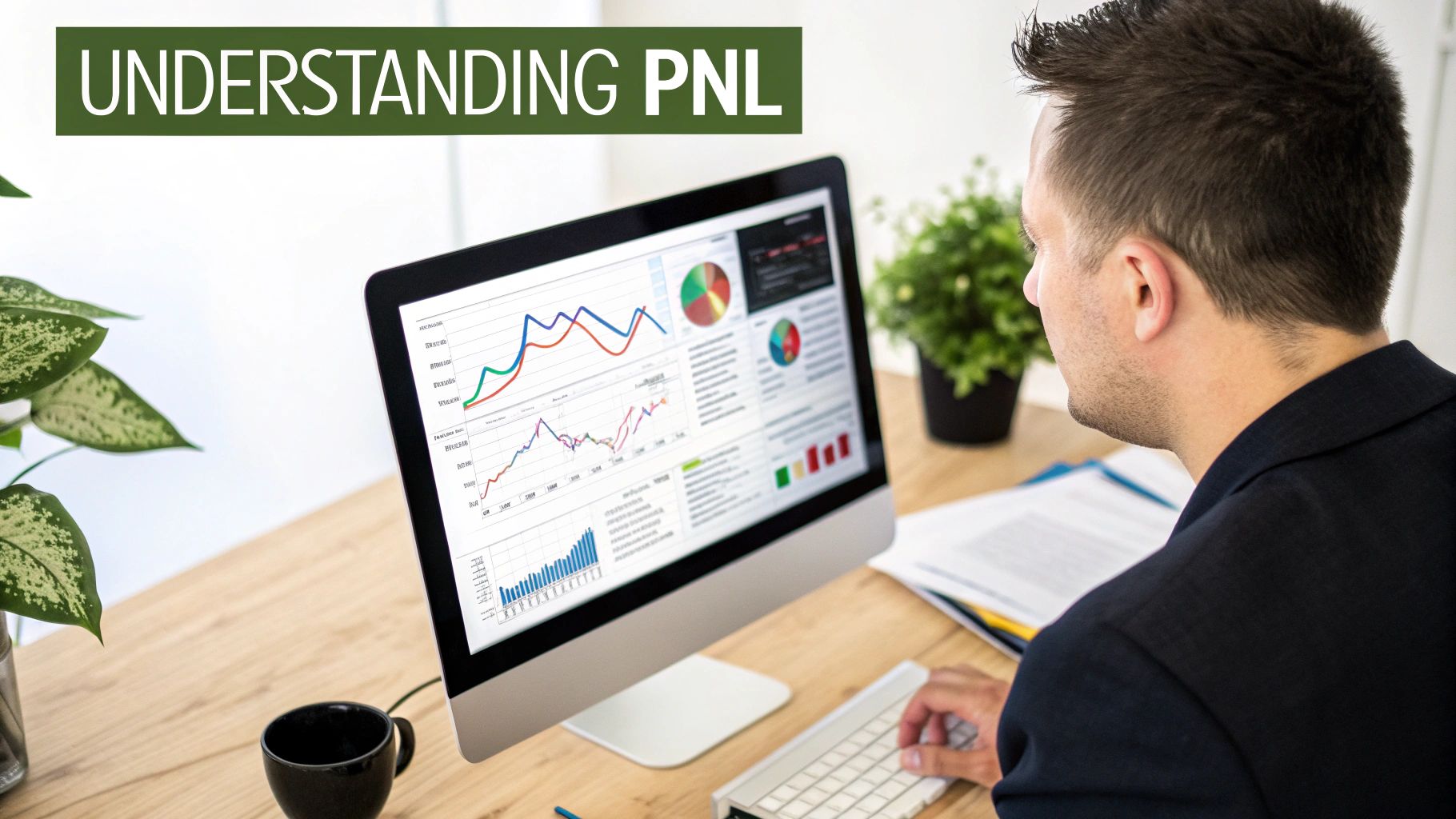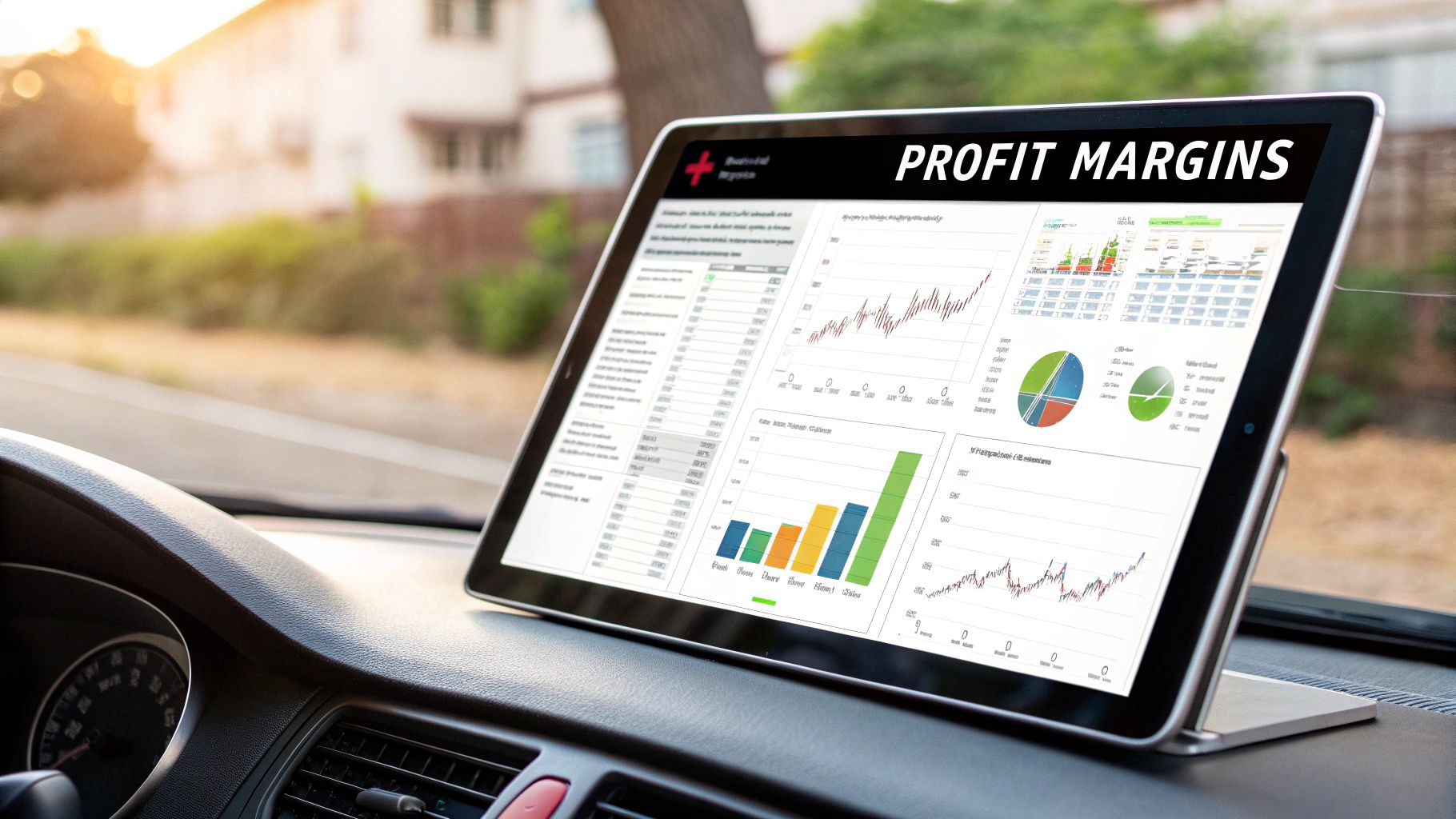Decoding PnL in Finance: Beyond Basic Statements

A Profit and Loss (PnL) statement is a critical tool for understanding a business's financial health. It's more than just a transaction record; it offers valuable insights into revenue streams, expenses, and overall profitability. These insights empower businesses to make informed decisions and promote future growth.
Imagine a TikTok Shop seller using Mergoio to analyze their PnL. They could identify top-selling products, pinpoint areas of excessive advertising spending, and optimize pricing strategies to maximize profits.
Understanding the Power of PnL Analysis
The ability to dissect financial performance is what separates thriving businesses from struggling ones. Astute professionals use PnL insights not only to track money flow but also to identify emerging opportunities and address performance issues before they escalate.
For example, a consistent increase in the cost of goods sold (COGS) could indicate a need to renegotiate supplier contracts or explore alternative sourcing. This proactive approach allows businesses to adapt to changing market dynamics and maintain a healthy financial trajectory.
The dynamic nature of profitability is highlighted by recent data from the UK. The net rate of return for private non-financial corporations (PNFCs) fluctuated, reaching 8.8% in Q2 2024, a decrease from 9.0% in Q1 2024, largely influenced by changes in net operating surplus. However, services companies saw their profitability rise to 15.1% in Q2 2024. For more detailed information, explore the UK Company Profitability Statistics.
Different Perspectives on PnL Data
Different stakeholders use PnL statements in various ways. Investors scrutinize quarterly reports to assess a company's financial stability and growth potential, influencing their investment decisions and helping them gauge the associated risk.
Executives, on the other hand, utilize PnL data daily for operational decisions, performance monitoring against budgets, and identifying areas for improvement. Department heads may use this data to track their team's contribution to the company's bottom line.
Practical Frameworks for Interpreting PnL Data
Effective PnL interpretation requires a structured approach. Trend analysis, comparing PnL statements over multiple periods to identify patterns in revenue, expenses, and profitability, reveals valuable insights into long-term financial performance and helps predict future outcomes.
Ratio analysis is another key aspect. Calculating financial ratios like gross profit margin and operating profit margin helps businesses assess their efficiency and compare their performance to industry benchmarks. These ratios can also highlight potential weaknesses in a company's financial structure.
By combining these techniques, businesses unlock the true potential of their PnL statements, gaining a competitive edge. This is how a seemingly simple document becomes a cornerstone of strategic decision-making.
Mastering PnL Components That Actually Matter

This section delves into the core components of a profit and loss (PnL) statement and how they reveal key business insights. Understanding these elements helps differentiate between minor fluctuations and significant trends. This detailed perspective empowers financial analysts to make informed, data-driven decisions.
Deconstructing Revenue Streams
Revenue is more than just a single number; it's comprised of various streams that tell a story. Analyzing individual streams, such as product sales, subscription fees, or licensing agreements, reveals which areas drive growth and which might be underperforming. For a TikTok Shop seller using Mergoio, this could mean pinpointing which products generate the most profit and which are lagging.
This granular understanding allows for effective resource allocation, focusing on high-performing areas while addressing weaknesses. For instance, a software company might discover its subscription revenue is growing steadily while one-time license sales are declining. This insight could prompt a strategic shift towards a subscription-based model.
Dissecting Expense Categories
Similar to revenue, breaking down expenses into distinct categories—such as cost of goods sold (COGS), marketing expenses, and administrative costs—provides a more comprehensive financial overview. Understanding these categories clarifies where money is spent and evaluates expenditure efficiency.
This detailed breakdown helps identify potential cost-saving opportunities. A rapidly growing e-commerce business, for example, might notice a sharp increase in customer acquisition costs. This could trigger a review of marketing strategies and a search for more cost-effective acquisition channels.
The Power of Margin Analysis
Margin calculations, such as gross profit margin and operating profit margin, offer crucial insights into profitability. These metrics reveal how much profit is generated for every dollar of revenue earned. Analyzing margins helps assess operational efficiency and pinpoint areas for improvement.
Comparing margins over time and against industry benchmarks provides a clear picture of a company's competitive position. If a company's operating margin consistently trails competitors, it suggests a need for operational improvements or pricing adjustments. Mergoio helps TikTok shop sellers understand their profit margins to identify areas for cost optimization.
Connecting the Dots: Spotting Interrelationships
The true power of PnL analysis lies in understanding the relationships between its components. A rising COGS combined with stagnant revenue, for example, signals potential pricing or supplier issues. A decrease in marketing expenses coupled with declining sales might indicate ineffective marketing strategies.
The following table provides a deeper look at the building blocks of a PnL statement:
PnL Building Blocks: What They Really Tell You
This table breaks down the critical components of a profit and loss statement, revealing their true significance beyond accounting definitions and how savvy analysts use them for deeper business insights.
| Component | Definition | Financial Significance | Analysis Tips |
|---|---|---|---|
| Revenue | Income generated from sales | Top-line growth indicator | Analyze individual streams for growth drivers |
| COGS | Direct costs associated with producing goods | Impacts gross profit | Monitor for efficiency and pricing pressures |
| Operating Expenses | Costs of running the business (excluding COGS) | Affects operating profit | Analyze categories for cost-saving opportunities |
| Gross Profit Margin | (Revenue – COGS) / Revenue | Measures production efficiency | Compare to industry benchmarks |
| Operating Profit Margin | Operating Income / Revenue | Measures overall profitability | Track trends over time |
By analyzing these interrelationships, financial analysts gain deeper insights into a company’s financial performance. This holistic view allows for more strategic decision-making, leading to enhanced profitability and sustainable growth. Identifying these patterns—and spotting red flags early—is essential for long-term success. This in-depth understanding transforms a PnL from a simple statement into a powerful roadmap for future growth.
Turning PnL Trends Into Strategic Foresight

Analyzing a single Profit and Loss (PnL) statement offers a glimpse into a company's financial health. However, analyzing trends across multiple PnLs reveals a more comprehensive story. This is where financial leaders can transform data into strategic intelligence. This foresight allows for more informed decision-making, ultimately driving sustainable growth.
Normalizing Seasonal Variations and Market Noise
One crucial step in effective trend analysis is accounting for seasonality. For instance, a swimwear company might experience a surge in revenue during summer and a decline in winter. To accurately assess underlying trends, financial professionals normalize these seasonal variations, allowing for a more precise comparison of performance across different periods.
Isolating meaningful patterns from market noise is also essential. External factors, such as economic downturns or shifts in consumer behavior, can significantly impact a company's PnL. By understanding performance within the broader economic context, businesses can identify genuine performance indicators. Tools like Mergoio help TikTok Shop sellers track their sales and profit trends, simplifying the process of identifying patterns and adjusting strategies accordingly.
Visualization and Predictive Metrics
Data visualization plays a vital role in making complex financial trends accessible. Charts and graphs effectively communicate financial performance to non-financial stakeholders, promoting better cross-departmental understanding and collaboration. A clear graph illustrating the relationship between marketing spend and customer acquisition cost, for example, can be instantly understood and acted upon.
Mastering predictive metrics is equally important. Key performance indicators (KPIs) derived from the PnL, such as customer lifetime value and recurring revenue, are strong predictors of future performance. These metrics provide insight into a company's long-term financial trajectory, enabling proactive strategic planning.
For example, the financial performance of UK companies can offer valuable insights into broader market trends. The Topps Group, a UK-based company, experienced significant financial fluctuations over a five-year period, oscillating between profit and loss. This volatility highlights the challenges businesses face in maintaining consistent profitability. Learn more about UK company financials.
Strategies for Extracting Deeper Insights
Even when standard comparisons prove insufficient, experienced financial analysts can uncover valuable predictive insights. They employ advanced techniques like regression analysis to understand the relationships between different variables within the PnL. They also use sensitivity analysis to evaluate the potential impact of various external factors on the company's financial outlook.
This strategic approach empowers financial leaders to anticipate challenges, pinpoint growth opportunities, and make informed, data-driven decisions. These methods allow businesses to move beyond simply observing past performance and actively shape their future financial success.
PnL Metrics That Drive Winning Business Decisions

Not all Profit and Loss (PnL) statement metrics carry the same weight. Some offer more profound insights into a company's financial health and predictive power for future performance. Understanding these key metrics allows businesses to focus their analysis and make informed decisions.
Key Performance Indicators (KPIs) Derived from the PnL
Several KPIs derived directly from the PnL statement provide a focused view of a company's financial performance. These KPIs offer valuable insights into different aspects of the business, from production efficiency to overall profitability.
Gross profit margin measures production efficiency. It’s calculated as (Revenue – COGS) / Revenue. A healthy gross profit margin suggests effective cost management within the production process.
Another important metric is operating profit margin, calculated as Operating Income / Revenue. This KPI measures the profitability of core business operations. Tracking it over time reveals trends in operational efficiency and pricing effectiveness. Tools like Mergoio can provide dashboards for real-time monitoring of these KPIs.
Net profit margin is the percentage of revenue remaining after all expenses are deducted. This bottom-line figure is a crucial indicator of a company's overall financial health and its ability to generate sustainable profits. It's especially important for e-commerce businesses with complex cost structures.
Finally, Earnings Before Interest, Taxes, Depreciation, and Amortization (EBITDA) provides a clear view of operational profitability before accounting for non-operating factors. This metric is useful for comparing companies with different capital structures or tax situations.
Benchmarking Against Relevant Competitors
Benchmarking PnL metrics against competitors provides valuable context for performance. However, it's essential to compare similar companies. Choosing competitors of similar size, business model, and target market ensures a meaningful comparison.
Understanding industry averages also provides valuable insight. Comparing KPIs against industry benchmarks reveals a company's strengths and weaknesses. This information can guide strategic decisions aimed at maintaining a competitive edge. For UK companies, the Office for National Statistics (ONS) provides valuable industry data. For example, the net rate of return for PNFCs was 9.9% in Q1 2023. More detailed statistics can be found here.
Utilizing PnL Insights for Strategic Decisions
PnL metrics are critical for informing strategic business decisions. They impact everything from pricing strategies to resource allocation and investment decisions.
Pricing strategies are often based on gross profit margins. Thin margins might necessitate price increases, while strong margins could allow for competitive pricing.
Resource allocation is often guided by operational profit margins. High-profitability areas can be targeted for further investment and growth. PnL insights also inform investment prioritization. By evaluating the potential return on investment based on projected PnL impact, businesses can make more informed decisions about capital expenditures.
The following table summarizes key PnL metrics, their calculations, and their impact on business decisions:
Decision-Driving PnL Metrics That Get Results
This comparison table showcases the most impactful profit and loss metrics used by successful companies, how to properly calculate them, and the specific business decisions they should influence.
| KPI | Calculation | What It Measures | Decision Impact | Industry Benchmarks |
|---|---|---|---|---|
| Gross Profit Margin | (Revenue – COGS) / Revenue | Production Efficiency | Pricing Strategies | Varies by industry |
| Operating Profit Margin | Operating Income / Revenue | Core Business Profitability | Resource Allocation | Varies by industry |
| Net Profit Margin | Net Income / Revenue | Overall Profitability | Financial Health Assessment | Varies by industry |
| EBITDA | Earnings Before Interest, Taxes, Depreciation, and Amortization | Operational Profitability (excluding non-operating factors) | Investment Decisions | Varies by industry |
This table highlights how different PnL metrics provide insights into various aspects of a business's financial performance. These metrics should be compared against industry benchmarks to provide context and identify areas for improvement.
Through careful analysis of PnL metrics, businesses can make data-driven decisions that lead to increased profitability and sustainable growth. This deeper understanding empowers financial leaders to translate numbers into actionable strategies. For example, TikTok Shop sellers using platforms like Mergoio can analyze their data to optimize pricing and product selection.
Overcoming PnL Analysis Blind Spots
Even seasoned financial professionals can sometimes struggle with interpreting Profit and Loss (PnL) statements. This section explores common complexities that can lead to misinterpretations or missed insights in financial PnL analysis. By understanding these challenges, we can develop more robust and reliable financial analysis strategies.
Normalizing Data For Accurate Comparisons
One common hurdle is comparing the PnL of companies using different accounting policies. For example, one company might use straight-line depreciation, while another opts for accelerated depreciation. These variations can significantly skew profitability comparisons. To address this, financial analysts often normalize the data, adjusting for these discrepancies. This means restating financial figures to a common basis for more accurate comparisons.
Separating One-Time Events From Operational Realities
Another challenge lies in isolating the impact of one-time events on the PnL. A large, one-time expense, like a restructuring charge or legal settlement, can temporarily impact profitability. Conversely, a one-time gain, such as from an asset sale, can artificially inflate profits. It's crucial to separate these non-recurring items from regular operational performance to accurately assess the underlying business health. Tools like Mergoio can help e-commerce businesses, such as those selling on platforms like TikTok, accurately track expenses and revenues, making it easier to spot unusual transactions.
Reconciling Conflicting Signals
PnL metrics can sometimes present conflicting signals compared to other financial indicators. For example, a company might report strong revenue growth but weak cash flow. This could indicate problems with collections or aggressive revenue recognition practices. Reconciling these conflicting signals requires a more holistic view, integrating insights from the balance sheet and cash flow statement, especially important in online retail where various sales-associated costs need to be tracked.
Supplementing PnL Data For A Comprehensive View
Finally, PnL data rarely tells the whole story. Macroeconomic trends, industry-specific dynamics, and competitive pressures all influence profitability. For example, the Reuters Institute's Digital News Report highlights rising costs and declining advertising revenues impacting UK industries. While focused on media, these economic pressures affect various sectors, influencing profitability and financial stability. Supplementing PnL analysis with external data and qualitative research provides a more nuanced and complete understanding of business performance, contextualizing PnL data for strategic decision-making.
Creating a 360° Financial View With PnL at the Center
A Profit and Loss (PnL) statement offers a vital snapshot of a company's financial performance. However, to truly unlock its potential, it's essential to integrate the PnL with other key financial data. This section explores how successful financial leaders combine PnL data with balance sheet metrics, cash flow indicators, and operational KPIs to create a comprehensive understanding of their business.
Building Integrated Financial Dashboards
Modern companies are moving beyond standalone PnL analysis. They're building integrated dashboards that combine PnL data with other crucial financial information. This interconnected approach reveals vital relationships that might be missed in isolated reviews.
For example, combining PnL data with balance sheet metrics such as accounts receivable and inventory turnover illustrates how effectively a company manages its working capital. This combined view could reveal that while revenue is growing, slow collections are negatively impacting cash flow and profitability.
Similarly, integrating cash flow indicators with PnL metrics explains differences between reported profits and actual cash generation. A company might show strong net income but struggle with negative operating cash flow. This discrepancy might indicate issues with revenue recognition or unsustainable growth in accounts payable, emphasizing the importance of considering multiple financial perspectives.
Leveraging Connections for Enhanced Decision-Making
By connecting the relationships between different financial statements and operational data, businesses gain valuable insights. This integrated perspective enables more accurate financial forecasts by considering broader financial drivers, not just past PnL trends.
This multifaceted analysis allows companies to develop more robust scenario planning. For instance, they can model how changes in interest rates (from the balance sheet) affect future profitability (from the PnL). This integrated view informs strategic pricing decisions and guides inventory management strategies.
Elevating Strategic Planning Through Integrated Analysis
A 360° view of financial performance empowers businesses to anticipate market shifts and proactively adjust their strategies. By incorporating operational KPIs, like customer acquisition cost or website traffic, alongside traditional financial data, companies can identify early warning signs of changing customer behavior or emerging competitive threats. This early detection allows for quicker adaptation and helps maintain a competitive edge in dynamic markets. For example, a TikTok Shop seller might observe declining sales coupled with increasing customer acquisition costs, prompting a strategic shift in marketing tactics.
Practical Implementation for Financial Professionals
Financial professionals looking to enhance their strategic contributions can implement this integrated approach using tools like Mergoio. This software helps e-commerce businesses, including those on TikTok Shop, track profit and loss alongside detailed sales data, marketing expenses, tax implications, and other vital metrics within a unified dashboard. Mergoio's advanced analytics features allow users to seamlessly connect various financial data points, revealing critical relationships and enabling data-driven decision-making.
Get started with Mergoio today and gain a 360° view of your financial performance.

Leave a Reply